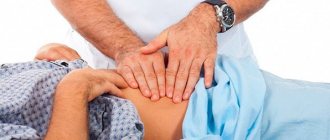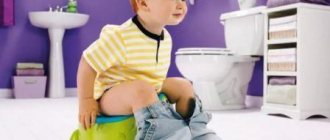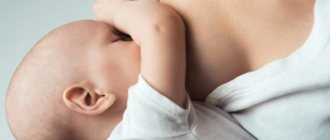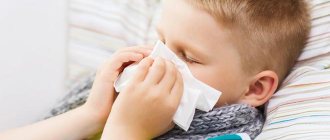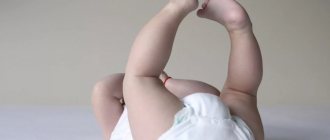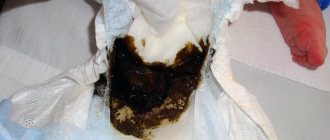Every person has experienced diarrhea at least once in their life. Disturbances in a child are especially concerning when the condition is accompanied by an increase in body temperature. In order to carry out effective treatment and not harm the baby, it is important to understand the reasons for the development of unpleasant symptoms. Why might a baby develop fever and diarrhea? When should you go to the hospital, and what help can you provide yourself?
Causes of diarrhea with fever
Diarrhea with fever can be an alarming symptom. How dangerous this condition is depends on the factors that provoked its appearance.
The causes of diarrhea at fever can be divided into:
- Non-infectious.
- Infectious.
If high fever and loose stools are caused by a non-infectious pathogen, the problem can be solved quickly. This does not always require the help of a doctor. If the baby becomes infected with an infectious disease, qualified treatment is necessary.
Non-infectious factors of occurrence
Causes not related to infection, but which can cause fever and diarrhea:
- teething;
- drug intolerance;
- poisoning;
- overfeeding;
- diet of a nursing mother;
- introduction of complementary foods;
- diseases of the gastrointestinal tract;
- stress.
To distinguish between dangerous signs of infection and a normal reaction to teeth, it’s worth taking a closer look.
Signs of teething
Fever and diarrhea in a child often develop during teething. This process affects absolutely everyone. For some, tooth growth begins at 5–8 months, for others closer to one year of age.
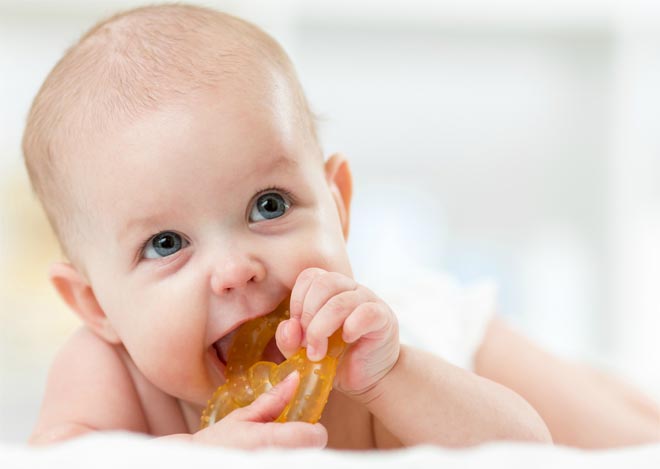
The peculiarity of dyspeptic symptoms when teeth appear in a child under one year old is that after a day or two the symptoms weaken, the diarrhea stops, and the temperature returns to normal.
Diarrhea due to medications
Although parents rarely give their children medications that are not prescribed by the attending physician, even they can provoke unpleasant phenomena. Because of this reason, the following symptoms may appear:
- rash;
- cough;
- itching;
- heat;
- diarrhea.
To reduce the negative effects of medications on the child’s body, it is necessary to stop using these drugs and consult a doctor for advice.
Food poisoning disorder
No matter how hard parents try to closely monitor the baby’s diet, sometimes low-quality food products cause problems in the digestive system.
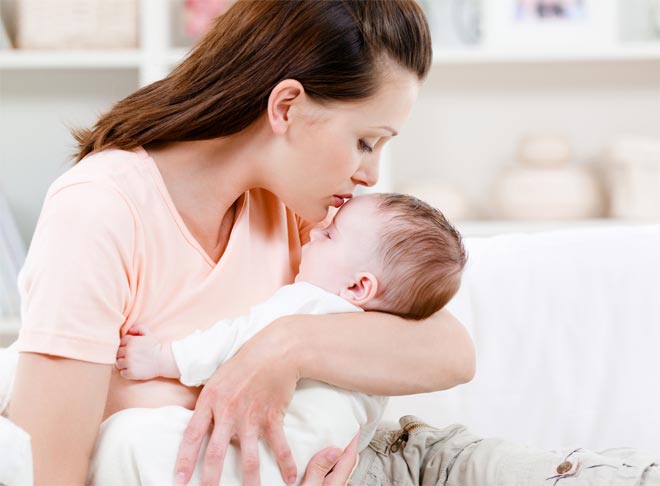
In case of poisoning, body temperature can rise to 38–39 degrees. The child experiences a strong fever and weakness. Attacks of nausea and vomiting are possible.
With frequent bowel movements and vomiting, you should try to replenish the volume of lost fluid. For this purpose, it is important to provide the baby with plenty of fluids, and in case of vomiting, you can give several tablespoons of warm water every 2 minutes.
Problems due to overfeeding
Too large portions, even breast milk, can provoke the development of dyspeptic symptoms, accompanied by body temperature. To avoid this, a woman must follow a diet.
There should be approximately an equal amount of time between each meal. You should not often shift the baby from one breast to another so that he has time to draw milk from the posterior chamber, since it is more nutritious and more enriched with valuable enzymes for normal digestion.
Errors in the mother's diet
A woman’s menu directly affects the quality and chemical composition of milk. It is necessary to monitor not only the child’s diet, but also your own.
Eating spicy, salty, smoked foods can lead to intestinal upset in a child. Particular attention should be paid to medications taken by women. Sometimes medications penetrate into the milk and affect the baby’s well-being.
Abrupt introduction of complementary foods
Diarrhea accompanied by high fever often occurs due to improper introduction of complementary foods. You can give your baby new foods no earlier than 6 months. Before this, the enzymatic system is practically not formed, and the digestion of ordinary foods becomes impossible.
You should not start complementary feeding with fresh fruits and vegetables, even if they are pureed.
Gastrointestinal diseases
The reasons why some children develop a fever and diarrhea may lie in diseases of the digestive tract. Some pathologies are congenital.
For example, dysbiosis develops due to a violation of the intestinal microflora. Problems appear after a course of antibiotic therapy. To restore, the diet is adjusted and lacto- and bifidobacteria are prescribed.
Stress
No matter how old a child is, he is susceptible to emotional disruptions and experiences. Even a newborn baby may show signs of anxiety if for some reason he does not find his mother nearby.
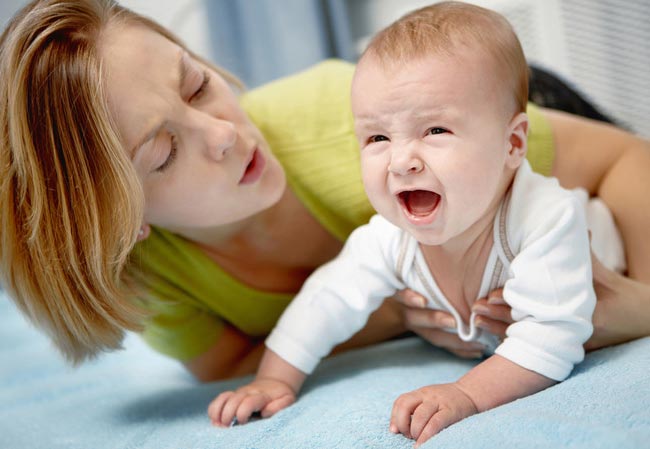
Stressful situations cause intestinal spasms, and children begin to experience diarrhea. The condition is rarely accompanied by an increase in temperature, but when the problems are protracted, this phenomenon occurs.
Infectious factors causing diarrhea
However, green diarrhea with water and a rise in temperature to 37–39 degrees in a baby may indicate the development of an infectious disease. To understand what to do in this case, parents must be able to distinguish between the main symptoms of the disease and a common malfunction of the intestines.
A significant increase in temperature and dyspeptic symptoms can be caused by the following diseases:
- rotavirus;
- measles;
- enterovirus;
- rubella;
- scarlet fever;
- flu;
- otitis;
- angina;
- rhino-pharyngitis;
- salmonellosis;
- dysentery.
To prevent complications and receive quality medical treatment when the first signs of pathology appear, you must immediately consult a doctor.
Some features of infectious diseases
Sometimes an infection can be suspected based on certain symptoms that appear in children. With enterovirus and rotavirus infections, the following phenomena are present:
- frequent watery stools up to 20 times a day;
- greenish tint to stool;
- specific unpleasant odor.
When salmonella, E. coli or dysentery pathogens penetrate, the following signs appear:
- heat;
- the presence of mucus in the discharge;
- foul odor of stool;
- the stool becomes swamp-greenish.
With intestinal infections, diarrhea with blood may appear.
Features of acetonemic crisis
Some parents know firsthand what “acetone” is. At the time of an acetonemic crisis, children’s body temperature rises and diarrhea begins. This disease is diagnosed after reaching one year of age.
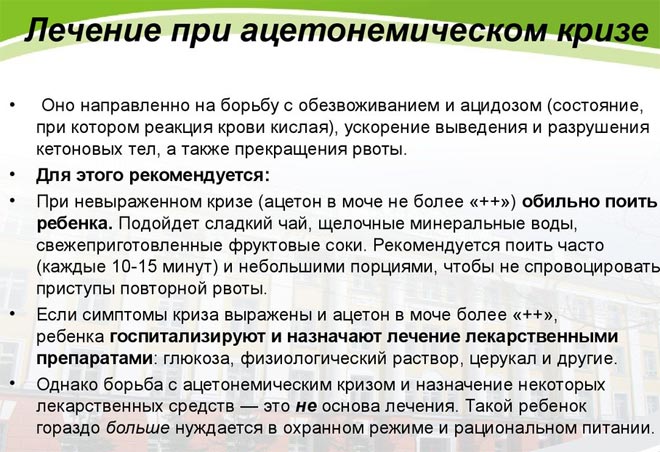
Children feel severe weakness, suffer from repeated vomiting and loss of strength. Medical attention required.
The child has diarrhea and a rash
The reasons for the appearance of such symptoms on a child’s body can be very different. Only a specialist should make a diagnosis and prescribe treatment. Otherwise, you can only aggravate the already not very good condition of your baby, as well as blur the symptomatic picture, which will complicate the doctor’s work in identifying the disease.
- Causes and treatment of rash with diarrhea in children Infectious diseases
- Allergic reactions
- Poor nutrition
- Neurotic reactions
REACTIONS OF A NEUROTIC CHARACTER
If the child himself is restless, often gets scared and cries, has difficulty making contact, and sleeps poorly, then diarrhea and a rash of a neurotic nature are possible.
For example, a loud voice or noise can trigger cases of loose stool.
Such children should pay more attention; you can try to relieve stressful conditions with herbal decoctions only (with appropriate consultation with a pediatrician).
CLINICAL PICTURE (PATHOGENESIS)
Diarrhea in a baby at first is quite normal, as his intestines begin to work and learn to digest food. But there are symptoms that indicate the presence of a disease in a child, these include:
Fever, rash, vomiting, diarrhea, discharge has an unpleasant odor, greenish color and foams.
This reaction of the body indicates an infectious lesion of the intestines. Microbes can enter the body through dirty nipples, unwashed fruits and vegetables, poorly cooked meat, etc.
Once in the intestines of a child whose immune system is not yet working well enough, they settle on its walls. Then, as the bacteria consume the nutrients, they release toxins and prevent essential nutrients from being absorbed into the blood.
The baby loses weight, becomes lethargic, and his body becomes dehydrated. Foamy diarrhea in a child can cause serious complications and therefore requires special treatment.
The stool is very liquid, almost just water.
It speaks of impaired absorption capacity of the intestine, or the presence of excess fluid in the diet.
If loose stools are accompanied by a rash, vomiting, and fever, this indicates bacterial damage to the body.
Enzymatic activity is disrupted and food may simply not be digested in the small intestine, causing gas, bloating, and rashes. Characterized by severe dehydration.
If the baby consumes too much liquid, his lips dry out and crusts appear around the mouth, and there is an increased sugar content in the urine, then this is most likely due to a malfunction of the pancreas.
The stool contains blood and mucus.
If you observe blood or mucus in the contents of the diaper, or if the stool is not of a natural color, then you should be wary. Of course, before starting treatment, you need to call a pediatrician, or in especially difficult cases, immediately an ambulance. Only a doctor can make a diagnosis and determine a treatment regimen.
The presence of blood and mucus indicates the presence of inflammation in the large intestine. Remember whether the child previously suffered from constipation, whether there was pain, itching, skin rashes, or burning in the rectal area. If such symptoms are present, then this indicates a fissure in the anus, or mechanical damage to the intestinal walls; an ulcer should not be ruled out.
Changed color of loose stool indicates possible damage to the liver and gallbladder.
WHY DO THERE ARE TEMPERATURE, ITCHING, AND VOMITING TOGETHER WITH RASHE AND DIARRHEA?
The etiology (origin) of itching, vomiting, rash and diarrhea can be generally divided into two types:
- Microbial. In part, it can also be called toxic, since the body is poisoned by harmful waste products that are released by bacteria that have settled in the body. The main “station” for cleansing the body of waste and toxins, in addition to the intestines, is the liver. An excess of harmful substances causes overload and malfunctions in its work, as evidenced by the appearance of a rash and itching. Most often, red spots appear on the face, wrists, and back. Itchy irritation on the bridge of the nose indicates diseases not only of the liver, but also of the intestines. When the body is completely overloaded with poisons, then in addition to red scratches on the body, vomiting, diarrhea, and fever appear.
- Toxic. Unlike microbial, toxic etiology is much more life-threatening in its effect on the body. Harmful chemical compounds that enter the child’s body are much more concentrated than the waste products of bacteria. Child mortality from toxic poisoning is much higher than from harm caused to their bodies by bacteria. Most often, this type of poisoning occurs due to poor quality food products or as a result of accidents. Nowadays, many detergents have a pleasant aromatic scent, and children, due to the carelessness of their parents, can taste them.
HOW TO TREAT
The treatment method for diarrhea and rash in a child is prescribed depending on what causes these symptoms. If it is a cold, virus or flu, then the main treatment method is to take antibiotics.
But be careful, if possible, it is better to do without them, since they are allergenic and cause dysbiosis in the intestines. Allergies are most often caused by antibiotics of the penicillin group.
It is best to try drinking baby syrups, herbal infusions and, of course, you must follow a diet.
No serious treatment is applied to “childhood” diseases at all. During such illnesses, the child is given various vitamin complexes, and cooling lotions are used to relieve itching on the skin.
During the period of allergic exacerbation, children need to be given Suprastin, Dezal and similar drugs. You should follow a diet; if the reaction is accompanied by severe diarrhea, you should drink activated charcoal.
It will cleanse the liver and intestines of waste and toxins and slightly alleviate the baby’s condition.
If the allergy is caused by a specific product, for example, fish, citrus fruits, nuts, then you should completely exclude it from the diet forever.
THIS IS INTERESTING
Often, children's illnesses can signal to us about problems in the family. If a child has ear pain and vision problems, it means that things are happening in the family that the child considers unacceptable to see and hear.
This may include, for example, insults, regularly recurring sensitive situations, pressure from parents. If a child often has a fever, cough, diarrhea, or rashes, then this indicates a tense situation in the family, when parents are arguing with each other.
Red spots all over the body, frequent burns and itching indicate internal anger that the child is holding back.
Frequent diarrhea and spontaneous excretion of feces indicate a strong fear that the baby experiences in his soul. Panic and anxiety arise as a result of the influence of parents who impose false fears, for example, “don’t go there, the gypsies will steal you there” and the character traits of the smallest person.
Such a serious illness as asthma can occur due to fear and distrust of life, unwillingness to live at all, a feeling of confinement and isolation. This is probably why salty sea air has such a beneficial effect on healing.
Almost any disease comes for a reason; the nervous and immune systems are closely interconnected and strongly influence each other. You may notice that after severe and prolonged stress, various serious illnesses arise. The immune system is weakened, and all vital energy is thrown into the fight against negativity.
But you should not try to protect your child from all troubles and adversities, otherwise there will come a time in life when they will fall on him at once. You should accustom him to reality gradually, giving information in doses.
Source: https://ponoss.ru/lechenie/u-rebenka-diareya-i-syp.html
Principles of treatment of diarrhea with fever
In order not to waste precious time, parents must clearly understand how to treat the baby. This is especially important when there is a newborn baby in the house.
If the temperature rises, especially to critical levels, it is better not to waste time, but to quickly call an ambulance. Only specialists can provide quality assistance to a child without causing harm. During the daytime, you can limit yourself to calling a local pediatrician at home.
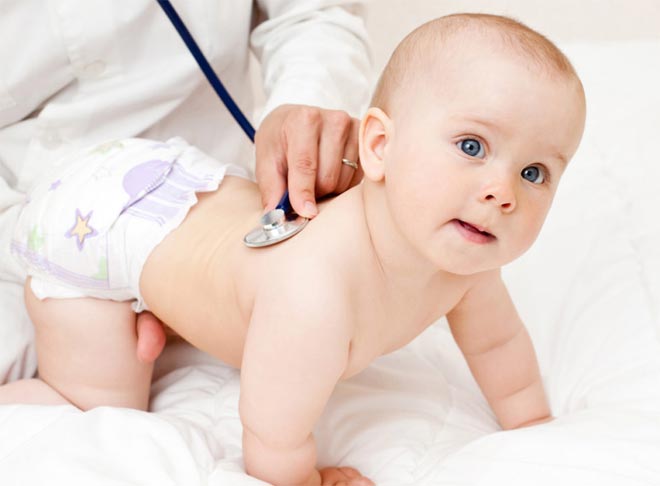
Although there is no need to panic, it is important to be attentive and sensitive to any changes in the child’s well-being and behavior. You should not immediately give any medications, especially antibiotics.
Video: What to do if there is an increase in temperature with diarrhea and vomiting?
Attentive attention to the baby’s health will allow you to maintain his health in order and, if necessary, promptly seek medical help. Only a doctor can accurately diagnose and recommend appropriate medications.
Source
Reading time:
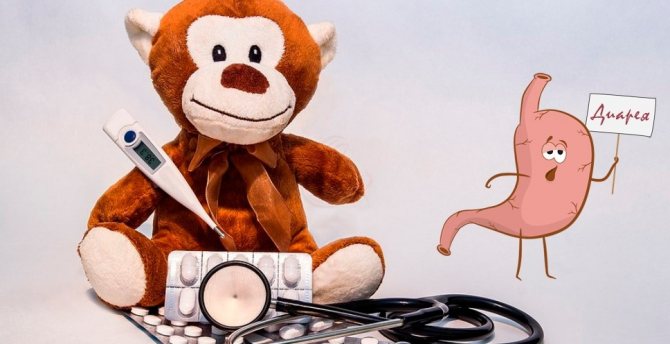
38℃ and diarrhea for up to a year
Fever up to 38℃, along with intestinal upset and, as a rule, diarrhea, is a common occurrence in young children. Every parent should know how to act in the event of such symptoms, when to call a doctor, and how to help the baby before he arrives.
The baby's body temperature should be measured correctly - this is done several times during the day, fixing the thermometer in the armpit or inguinal fold. It is permissible for newborns to measure their temperature through the rectum. It is recommended to write down all the measurements taken and the symptoms that the child has, so that later the doctor becomes familiar with the dynamics of the patient’s well-being, and you do not forget the readings.
Hyperthermia up to 38℃ in an infant should not be reduced with antipyretics. Medicines are appropriate for children suffering from convulsive conditions under the supervision of a neurologist, and for anyone under 3 months of age. An antipyretic should be given immediately if, in addition to an increase in temperature, pale skin and chills are observed.
Main signs of diarrhea
Normally, the stool of a healthy child is brown in color without impurities or inclusions, and its consistency during artificial feeding is denser than that of infants who are breastfed. These babies have a normal stool frequency of 1–3 times a day. After the introduction of complementary foods, the frequency of bowel movements in a child may decrease, for example, once every 1–2 days. But in this case, everything will depend on the type of products that were introduced into the diet.
We recommend: How to treat severe diarrhea in infants: causes of the disease and recommended remedies
Diarrhea in a bottle-fed baby is the appearance of loose, possibly watery or foamy stools, repeated more than 6 times a day. Feces may contain various inclusions, such as undigested food residues, blood or mucus. Diarrhea is often accompanied by abdominal pain, fever and other unpleasant symptoms.
Causes
Only a doctor can make an accurate diagnosis, who will study the symptoms as a whole and find out the cause of their occurrence.
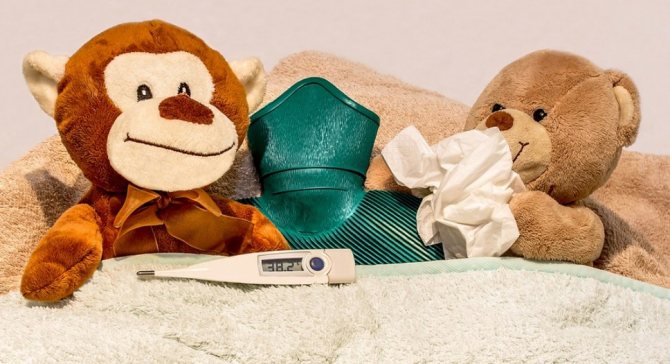
When the pediatrician arrives, parents should be prepared to answer the following questions:
- whether the child had contact with those diagnosed with an infectious disease;
- whether intestinal upset was observed before the temperature increased;
- whether a rash or redness of the skin is noticeable on the body.
Medicine identifies two reasons why a baby may develop diarrhea and fever:
- infectious onset,
- non-communicable disease.
Often, dysfunction of the intestine, which is caused by a non-infectious reagent, is restored quickly and proceeds without a trace. The main reasons why a baby suffers from diarrhea and fever are:
- food that is poorly digestible by a small body;
- acetonemic syndrome;
- hypersensitivity to some components of medications;
- teething.
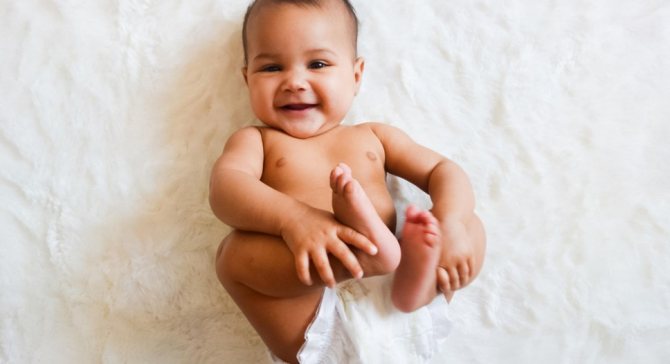
When fever and diarrhea in an infant are observed as a result of the penetration of an infectious pathogen into the body, there are a lot of complications that can occur as a result of this. One of the most dangerous complications is dehydration, which can be fatal if medical care is not received in a timely manner.
The most common cases when an infant has a temperature disturbance within 38 degrees and diarrhea are acute intestinal infectious diseases. The cause of their occurrence is rotavirus infection or enterovirus.
Causes of 38℃ and diarrhea in infants
| Disease | What other symptoms? | What to do? |
| Rubella, scarlet fever or measles | These three diseases are similar in primary symptoms, which manifest themselves in the form of diarrhea and fever up to 38 degrees. | Only a doctor can accurately diagnose the disease. Self-medication can be dangerous and worsen your general condition. It is important to observe quarantine and limit the child from strangers who have not yet suffered these infections. |
| Flu or sore throat | Diarrhea and 38℃ are the first harbingers of a sore throat or flu. With their appearance, it is important to monitor other possible symptoms - redness in the throat, enlarged lymph nodes and tonsils, runny nose, cough. | If these signs appear in combination or individually, you should immediately show the baby to a pediatrician in order to make an accurate diagnosis and prescribe timely treatment. |
| Intestinal infection | Infectious diarrhea can be classified into types: osmotic, secretory and invasive. Each of them is characterized by symptoms in the form of bloody discharge from the intestines and the signs we are discussing. | A general condition characterized by fever and diarrhea requires an immediate call to the doctor to prevent complete destruction of intestinal enterocytes by pathogens, which can lead to disruption of the gastrointestinal tract as a whole. |
| Acetonemic syndrome | Insufficient amount of carbohydrates in the body, food load, stressful situation, infection are the causes of fever and diarrhea in infants as a result of acetone syndrome. This disease can be diagnosed by the characteristic smell of acetone from the mouth along with the above symptoms. Constipation is also possible. | Acetone syndrome diagnosed by a doctor is treated at home by washing the intestines, replenishing dehydration and taking sorbents. Timely seeking medical help will allow you to avoid metabolic disorders in the future and forget about this disease forever. |
| The body's response to individual components of drugs | Iron-containing products can cause a baby's temperature to rise to 38 degrees and diarrhea. | Such a reaction can be avoided by eliminating the use of intolerable medications. In order to determine which ones specifically, you should consult a doctor. |
| Response to the growth of the first teeth | This is the most common reason why a baby may develop hyperthermia of this magnitude and diarrhea. | To make sure that such symptoms are the body’s response to growing teeth, you should check your gums - they will be slightly swollen and red. To relieve inflammation, you can use products with a freezing effect or wait 2-4 days and the condition will improve on its own. |
| Ingestion of foods that are difficult for the body to digest, poisoning | Children's immature enzymatic system can react to the consumption of difficult-to-digest foods with fever and intestinal upset. | Chocolate-containing, smoked foods, and carbonated drinks should be excluded from the child’s diet. |
Rash and diarrhea in infants
The reasons for the appearance of such symptoms on a child’s body can be very different. Only a specialist should make a diagnosis and prescribe treatment. Otherwise, you can only aggravate the already not very good condition of your baby, as well as blur the symptomatic picture, which will complicate the doctor’s work in identifying the disease.
- Causes and treatment of rash with diarrhea in children Infectious diseases
- Allergic reactions
- Poor nutrition
- Neurotic reactions
CAUSES AND TREATMENT OF RASH WITH DIARRHEA IN CHILDREN
Diarrhea and rash on the body can be the result of the following factors:
Infectious diseases
Among the most common “childhood” diseases that can cause rashes and loose stools are chickenpox, measles, scarlet fever and rubella.
chickenpox
It is better, of course, to get over it in childhood, because in adulthood it is very difficult to bear, leaving serious consequences.
This disease begins with a general malaise, the child is lethargic, eats poorly, has a fever, and possible diarrhea.
Afterwards, a rash appears, first it is localized in one place, and then spreads throughout the body, including the mucous membranes and head.
How to help children? The rashes that appear should be treated, you can do this with brilliant green in the old fashioned way, or use modern alcohol-containing lotions that dry out the bumps and cool them, relieving itching. You cannot rip off the scabs or pierce the tubercles, as scars may remain. If you have problems with your intestines, use products containing probiotics.
MEASLES
It has symptoms very similar to respiratory colds, such as chills, cough, runny nose, general malaise, high fever, rash. Then, after some time, red spots begin to appear, first they are localized on the face and neck, and then spread further throughout the body.
Against the background of high temperature, vomiting and diarrhea may occur. This disease has a strong impact on the immunity of children, significantly weakening it.
The consequences of the disease can be different - these include infectious diseases of the lungs, cystitis, otitis, damage to the nervous system, rashes, and various types of intestinal disorders.
There is no vaccine for treatment; the immune system of children must cope with this disease on its own, after which it develops lasting immunity. As therapy during the treatment period, you can take vitamins, you must follow a diet. Measles also greatly affects the intestinal microflora, causing disorder in the form of diarrhea.
RUBELLA
It appears as a red rash all over the body. Symptoms are the same as a common cold, the child’s temperature rises, weakness appears, and possibly a slight intestinal upset. The rash appears first on the face and neck, then moves down the body. There is no treatment; contact of the sick baby with others should be excluded until the red spots disappear.
ALLERGIC REACTIONS
They are seasonal, exacerbation occurs in the autumn-spring period. Most often, an allergy to something is associated with a general decrease in immunity and disturbances in the liver.
Also, rashes and diarrhea often occur due to mistakes in feeding the child.
If the baby is used to eating relatively simple food - porridge, soups, pasta, introducing exotic seafood, berries or citrus fruits into his diet can provoke an allergic reaction in the form of an itchy red rash on the skin, diarrhea, and fever.
To relieve these symptoms, you can take Suprastin, Dezal and similar drugs. Taking analgesics is not recommended, since they do not relieve allergy symptoms and only temporarily relieve itching. Allergenic foods should be excluded from the diet, and the little one should also be given activated charcoal to cleanse the digestive tract of toxins and follow an appropriate diet.
IMPROPER NUTRITION
The body of a child, and especially a newborn, is still weak and fragile. In the first months of his life, you should especially monitor his diet and the condition of his stool. The baby's intestines are longer than those of an adult, which determines its good absorption capacity.
But since the baby was in the womb for a long time and fed from her, the enzymatic activity of his intestines is poorly developed. Belching, dysbacteriosis, indigestion, diarrhea, fever, rashes - all these are possible symptoms of the intestines adapting to other conditions (outside the womb).
At first, only breast milk is present in the baby’s diet, which causes loose stools with pieces of curdled milk, then when complementary foods are introduced, it takes on the appearance of sour cream or soft sausage.
Source: https://podberi-mmc.ru/syp-ponos-u-grudnichka/
When diarrhea is accompanied by fever
A change in stool against the background of an increase in body temperature is considered a very serious sign. There are quite a few reasons that provoke such manifestations. All of them are divided into two groups - infectious and non-infectious.
If problems arise under the influence of physiological factors, coping with them can be quite simple. In this case, you can often do without medical help. If you become infected, qualified therapy will be required.
Physiological reasons
Fever and diarrhea in a child under one year of age are associated with the influence of various natural factors:
- Teething. All children face this process. For some, teeth begin to grow at 5-8 months, for others - closer to 1 year. A characteristic feature of the pathology is the weakening of symptoms 2 days after their onset. The child's stool and temperature return to normal.
- Taking medications. In addition to the main symptoms, some drugs provoke rashes, itching, and cough. To minimize such effects, you should stop using medications and consult your doctor.
- Overfeeding. Large amounts of food, including breast milk, can cause dyspeptic symptoms. They are characterized by an increase in temperature and all kinds of stool disorders. To avoid such phenomena, it is important to adhere to the feeding regime. There should be an equal amount of time between all meals.
- Disturbances in the diet of a nursing mother. A woman's menu affects the composition of breast milk. Therefore, it is important to control not only the baby’s diet, but also your own nutrition. Consumption of pickles, smoked meats, and spicy foods often causes disorders in a child. The medications that a nursing woman takes are also important. Sometimes they end up in milk and negatively affect the baby’s health.
- Violation of the rules for introducing complementary foods. You can give your child new foods no earlier than six months. Until this moment, its enzyme system is not well formed. Therefore, the child’s body is not able to digest ordinary foods. It is not recommended to start complementary feeding with fresh vegetables or fruits.
- Stressful situations. Regardless of the age of the baby, he is exposed to emotional overload and worries. Even newborn children experience anxiety if their mother is not around. These situations provoke intestinal spasms and lead to symptoms of diarrhea. With prolonged emotional overload, an increase in temperature indicators is observed.
Pathological factors
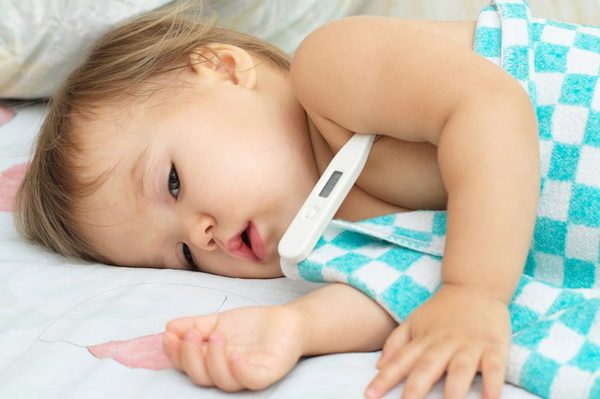
Common pathologies that are accompanied by such symptoms include the following:
- Food poisoning. Eating low-quality products can cause damage to the digestive organs. In this case, the temperature can increase to 38-39 degrees. The child develops general weakness. Nausea and vomiting are sometimes observed.
- Pathologies of the gastrointestinal tract. Some of them are congenital, while others are acquired by the child throughout life. Dysbacteriosis is considered a common cause of problems. Its development is caused by a violation of the intestinal microflora. This may be due to the use of antibacterial drugs. To restore the balance of microorganisms, bifidobacteria and lactobacilli are given. You should also follow a special diet.
- Acetonemic syndrome. The cause of its appearance may be a deficiency of carbohydrates in the body, increased dietary loads and stress. The characteristic acetone odor from the mouth helps to identify pathology. The child also has bowel movements. In some cases, the temperature increases.
Infectious causes
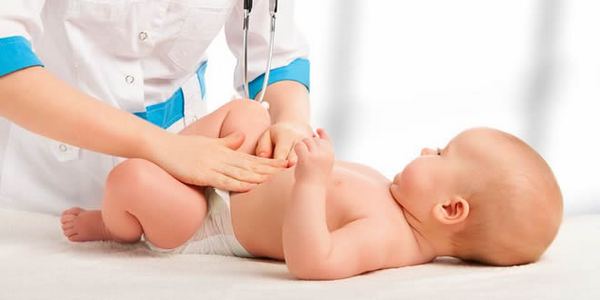
If your baby has a fever and diarrhea, you may suspect an infectious disease. To identify the disease in a timely manner, you need to analyze the main symptoms.
Fever and signs of dyspepsia can be caused by the following disorders:
- rotavirus infection;
- flu;
- inflammation of the middle ear;
- tonsillitis;
- enterovirus;
- measles;
- nasopharyngitis;
- dysentery;
- salmonellosis;
- rubella;
- scarlet fever.
To prevent complications and get rid of pathology in a timely manner, you should immediately consult a doctor. In some situations, it is possible to suspect an infection based on specific signs that appear in the child. With rotavirus disease and enterovirus, the following symptoms appear:
- frequent watery stools – present more than 20 times a day;
- special unpleasant odor;
- green tint of stool.
When infected with E. coli, dysentery, or salmonellosis, the following manifestations are observed:
- significant increase in temperature;
- mucous impurities in feces;
- unpleasant odor during bowel movements;
- swamp green tint of feces.
If a baby has an intestinal infection, there is a risk of diarrhea with bloody impurities. In this case, you should immediately call a doctor
A baby has a rash and diarrhea
Panic, confusion and fear for her beloved baby appear in a young mother when she suddenly notices diarrhea and a rash on the child’s body. To figure out whether such symptoms are dangerous or not, consultation and diagnosis of a pediatric specialist is necessary.
Whatever the disease, if a rash appears on the body, this indicates that a painful process has begun in the baby’s blood, and diarrhea can cause a serious infection. In pediatrics, there are no diseases that can be classified as mild if the main symptoms are diarrhea and skin rashes. Each case requires urgent medical attention.
Causes of diarrhea
Diarrhea and skin rashes on a child’s body can be symptoms of various ailments. It is very important to take into account the fact that at each age the same disease can occur differently.
If a teenager’s body can cope with it quickly, then the baby will tolerate it much harder. The reason for this is the age characteristics of the child’s body at different stages of development.
When diarrhea and rash appear, it is very important to provide the necessary assistance without causing complications.
The most common causes of diarrhea in children can be:
- intestinal disorders;
- allergic reactions associated with certain products or overdose of medications;
- E. coli infection;
- food poisoning;
- dysentery.
The most common cause of diarrhea (diarrhea) is E. coli, which affects the child’s body due to poor hygiene: unwashed hands, toys, fruits.
The disease may not go away for several days, which, with frequent diarrhea, can cause dehydration and lead to severe consequences.
If diarrhea is accompanied by elevated body temperature, vomiting, and there is mucus and blood in the stool, you should urgently call a doctor. The most common cases of such symptoms are hospitalization.
A second, no less rare cause of diarrhea in children is poisoning from stale food. In this case, the blame lies entirely with the parents, who, as a result of their negligence, allowed this fact to happen.
The worst thing in such a situation may be infection from stale fish or meat, which results in the development of a toxic infectious disease such as botulism.
It can affect the nervous system, and in some cases lead to disability and death. Drug poisoning is also dangerous for children.
Along with infectious intestinal diseases that cause diarrhea, it can also be caused by infectious diseases such as influenza and otitis media. Diarrhea may be accompanied by fever and rash.
Rash and diarrhea are not the main symptoms of these ailments, but due to the improper functioning of certain organs of the gastrointestinal tract, they may be present.
If the main symptoms of the flu for several days are accompanied by diarrhea, abdominal pain, green stools or bloody stools, you should urgently call a doctor.
How to treat diarrhea in a child
Before calling an emergency medical team, you must try to remove toxins from the child’s body and prevent dehydration. Under no circumstances should you give your baby fever-lowering medications for intestinal infections. The best way to prevent this is rehydron.
This is an absorbent drug that helps normalize the water-alkaline balance in the body. It is diluted in boiled water at the rate of 1 sachet packet per 1 liter of water and given to the baby to drink after each bowel movement.
For children over one year of age, enterosgel can be used, which is a good enterosorbent.
In case of poisoning with medicines and food, it is necessary to induce vomiting and rinse the stomach, give the child to drink absorbent drugs: activated carbon, white carbon, a weak solution of potassium permanganate.
If you experience diarrhea, pain in the lower abdomen as a result of the flu, or the baby constantly lies in a bent state, this is a reason to consult a doctor, undergo the necessary tests and, having received an accurate diagnosis of the accompanying problem, begin adequate treatment. If a child suddenly starts vomiting, under no circumstances should he be put to bed after the first urge. This can cause vomit to enter the respiratory organs.
Very often, children refuse food after the main symptoms of the disease have disappeared. Under no circumstances should you force a child to eat. He will still eat little by little, since a hungry body will require it.
It is better to give him protein foods during this period: boiled beef, chicken, fish. Fatty foods should not be given to children; they are poorly digestible. The baby's stomach was under enormous stress.
In order not to irritate his mucous membranes, you can give vegetables and fruits such as bananas, baked apples, and boiled potatoes. Eating porridges should be alternated with low-fat soups.
A few days after recovery, the baby can be given biokefir to normalize the intestinal microflora or take a course of probiotics if the doctor deems it necessary to prescribe them.
Why does a rash appear in children?
There are several reasons why children develop rashes on their bodies. These include:
- violation of the rules of personal hygiene of the child;
- allergic reactions;
- viruses and infections;
- diseases of the cardiovascular system.
The most famous rash in a newborn baby is heat rash, which can be caused by the fact that he is dressed warmly or the temperature in the room is too high for the baby. This is a harmless manifestation of the rash. It can be eliminated by undressing the baby a little and allowing his body to breathe.
You can wipe the baby with a damp cloth and give him something to drink. A rash on the body may appear due to poor child care.
If he is not bathed daily, diapers are not changed on time, folds are not wiped, diaper rash may appear on the body - a red rash, in advanced forms with infected pustules.
One of the most terrible manifestations of the rash is staphylococcus, which covers the body with purulent yellowish blisters.
The bubbles burst and cause re-rash.
A rash in the form of redness and small hives can be the cause of an allergic reaction to food. This rash is accompanied by itching and, in some cases, fever.
The baby sleeps poorly and refuses to eat. The worst thing can be a rash accompanied by swelling, which can cause angioedema and, as a result, anaphylactic shock.
In this case, urgent hospitalization of the baby is necessary.
The rash is the main symptom of infectious diseases such as measles, chicken pox, scarlet fever, rubella and meningitis. These diseases are characterized by certain treatment methods, which are prescribed by a pediatric infectious disease specialist depending on the child’s age.
To treat most manifestations of the rash, it is enough to eliminate its main cause. If the rash is caused by an allergy, it is necessary to eliminate the provoking product from the diet. If a child is diagnosed with insidious staphylococcus, antibiotics are the basis of treatment.
The doctor prescribes them according to a special network, since this disease has the ability to develop resistance to them. But there are cases when improper use has a side effect: the functioning of the digestive system is disrupted, and the drug allergen enters the bloodstream.
Rash and diarrhea are added to the underlying disease.
Illnesses with rash and diarrhea
Many childhood infectious diseases that occur in an acute form have complex symptoms. Children may simultaneously experience a rash, diarrhea, fever, and vomiting.
Very often, against the background of a violation of the intestinal microflora and the body’s immune system, a rash may appear after treatment with antibiotics for infectious diseases accompanied by diarrhea.
These include typhoid fever, severe forms of chickenpox, salmonellosis, atopic dermatitis, and food allergies.
If the disease has only one of these symptoms, and another appears later, this means that the disease has taken on a more severe form of development, and medical advice cannot be avoided. Under no circumstances should you thoughtlessly treat children with traditional methods for diarrhea or allergies. Once you start treating one problem, you can trigger another, which in most cases leads to complications.
Rash and diarrhea in the child can be a serious cause for concern for young parents.
To take action, you must consult your pediatrician.
Causes
Many serious illnesses can be hidden under such manifestations as diarrhea and rashes in a child. Moreover, the course of the disease is individual for each individual age and organism.
For teenagers, for example, it is easier to overcome the disease; children suffer more, since their body is not strong enough. The age-related characteristics that a child’s body exhibits at each stage of development can react differently to the problem that has arisen.
It is important that the necessary assistance is provided in a timely manner, which will protect the child from complications.
Source: https://limto.ru/u-grudnogo-rebenka-syp-i-ponos/
How to react to temperature
Antipyretics should be used if the temperature reaches 38.5 degrees. It is important to take into account that with infectious diseases, indicators increase rapidly. Therefore they need to be kept under control.
Indicators in the range of 41-41.5 degrees pose a danger to the baby’s life. In addition, high fever can cause febrile seizures.
The condition is characterized by impaired breathing, severe muscle tension, blueness of the body and erratic twitching. If the child has a history of febrile convulsions, the temperature should be reduced already at 38 degrees.
Another dangerous condition for children is white fever. In this case, the child’s skin remains pale and dry, and the limbs remain cold. Then it is very difficult to reduce the temperature, so you need to immediately call a doctor.
Methods for normalizing temperature are divided into 2 categories - household and medicinal. To improve your child’s condition, you need to do the following:
- remove the baby’s diaper and excess clothing, covering him with a light blanket;
- provide fresh air access to the room;
- give the baby water often;
- wipe the skin with a damp towel - if the baby has symptoms of white fever, this is prohibited.
As for medications, the baby can be given children's ibuprofen or paracetamol. The dosage should be selected depending on the age category and body weight of the child. Before starting to use such products, it is best to consult your pediatrician.
The choice of dosage form is also important. If you have diarrhea, it is better to give the product in syrup form. If a child vomits, you should use suppositories. It is important to take into account that the effect of rectal suppositories begins only after 40 minutes, while the effect of the syrup is achieved after 20 minutes.
What should “normal” stool look like?
In the first months, infants have loose stools - this is the norm!
In the first months of life, all babies have loose stools. This is considered normal. You should not react to the advice of “well-wishers” who claim that the chair should be decorated. Perhaps such people simply don’t remember how it should be or don’t know anything, but want to seem knowledgeable on this issue.
Read: Yellow diarrhea in a child: causes, symptoms and treatment of pathology
A newborn baby cannot have formed feces; in this case, he simply would not be able to perform an act of defecation. The child cannot yet sit or stand and receives only liquid food, so he should only have loose stools. The body cannot form normal feces for an adult, because solid food particles do not enter and formed feces simply have nowhere to come from.
Therefore, parents should be calm about loose stools, which in adults is considered a deviation from the norm. There is nothing wrong with this for babies. But if the baby has hard feces, constipation will begin, which you will have to fight with your own means. After all, delayed bowel movements cause no less problems than diarrhea.
Parents need to monitor the consistency and color of stool; these indicators may change with age. Moreover, changes can occur every day. Such mobility of indicators is more common in breastfed children. Mom's diet will have a noticeable effect on the color of her stool. Therefore, even if an unfamiliar color appears, there is no need to panic; you must first analyze what the nursing woman ate. Standard indicators are given below.
An elevated temperature should alert you!
The first hours, days after birth. The color of stool is dark, closer to dark green. This is the so-called meconium - original feces. It must definitely leave the baby's body. If this does not happen, the medical staff must be informed. The absence of meconium discharge often indicates pathology. For example, about intestinal atresia.
The first months. The norm is loose stool, the color can vary from greenish to golden. All shades of brown are acceptable. A small amount of mucous discharge is also normal. The stool should have a characteristic odor, reminiscent of sour milk. An unpleasant odor develops if the baby is artificially fed or on a mixed type of diet. In this case, it is impossible to predict exactly what the smell will be.
After six months, significant changes in consistency occur. The stool thickens and becomes creamy. The color also varies. We accept green, brown and yellow. If the baby is bottle-fed, the color can be dark green or yellow-brown.
Read: Remedy for diarrhea in children: how to treat diarrhea
Complications
The combination of diarrhea and fever poses a real danger to children. If measures are not taken in time, there is a risk of the following consequences:
- convulsive syndrome;
- fainting;
- dehydration;
- lactase deficiency – often occurs after rotavirus infection in infants;
- functional changes in the intestines - manifest themselves in the form of constant bowel irregularities and bloating;
- dysbacteriosis - this condition occurs against the background of infectious pathologies, for the treatment of which antibacterial drugs were used;
- rectal prolapse – develops after dysentery;
- fatal outcome.
How to treat diarrhea in children less than a year old
Diarrhea is a signal of a problem!
Diarrhea is a method that the body uses to protect itself from the negative effects of external manifestations. Therefore, there is no need to treat diarrhea itself; the cause of this condition should be identified and eliminated. But first, you need to protect your baby from the dangerous consequences of diarrhea. We are talking about dehydration, expressed in the loss of salts and fluids. This condition leads to serious disruptions in the functioning of internal organs.
Firstly, everything must be done to replenish the loss of fluid and salt. Parents are required to do this before receiving specialist advice. Secondly, it is necessary to carry out a set of measures that the doctor will prescribe. It is better not to self-medicate, because a child’s body can unexpectedly react to even the most familiar remedy.
Read along with this article:
- A child has yellow diarrhea: when is this normal and when is it pathological?
- Should you panic if your child has diarrhea with mucus?
- What causes diarrhea in a newborn, what to look for and...
- Diarrhea and pregnancy, causes of diarrhea
- Green poop in a baby: causes, methods...
- A collection of tips or What to do if a newborn has loose stools
- What to do if your one-month-old baby has diarrhea? In what cases does not...
- Diarrhea during pregnancy, is it dangerous?
- A newborn has a stomach ache, what to do, how to help and how to do it...
Prevention
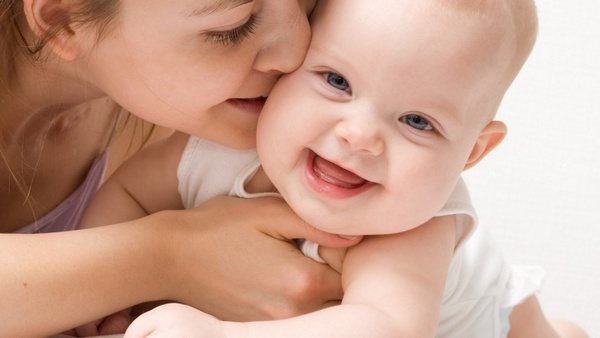
To avoid such problems, parents of the baby should familiarize themselves with the basic recommendations. To prevent intestinal disorders and infectious diseases, you must adhere to the following rules:
- Give your child only high-quality food. The baby’s diet should not contain expired foods, food with coloring additives, carbonated drinks, or flavor enhancers.
- Stick to a diet appropriate for your age. The menu of young children should not include smoked meats, mushrooms, or seafood. You shouldn't give them chocolate either.
- Provide a balanced diet. The menu should contain a lot of carbohydrates to prevent an acetonemic crisis.
- Strengthen your immune system. This will help the child resist infections.
- Create a favorable psychological environment in the family and eliminate stressful situations.
- Adhere to hygiene rules. Vegetables, fruits and berries must be washed thoroughly. You should also wash your child’s hands before eating.
- Young children should be given clean filtered or boiled water to drink.
- You should not bathe your baby in unknown bodies of water.
- Try to breastfeed your baby for as long as possible. At the same time, a nursing mother should eat a balanced diet.
- Avoid contact with infected people. This is especially important during epidemic periods.
- Ensure careful processing of meat, fish, eggs, and milk.
If you provide your baby with a balanced diet and proper care, taking into account age standards, you will be able to avoid the appearance of diarrhea and fever. If such symptoms do occur, you should immediately call a pediatrician. This condition is fraught with the development of dehydration, which poses a danger to the baby’s life.
Source
